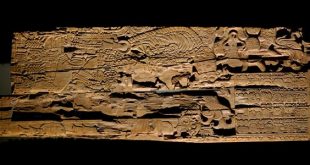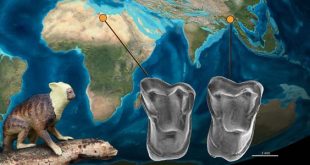A Maya carving has helped an international team of researchers to re-sync the European and Maya calendars and helps show that climate change played a role in the civilization’s collapse.
Read More »Giant camel fossil unearthed in High Arctic
The collagen fingerprint preserved in a leg bone from Canada’s High Arctic has been connected to a giant camel that lived there roughly three-and-a-half million years ago.
Read More »Mother to largest branch of mammals described by researchers
The first branch from the tree of life has been placed online by an international team of researchers and used to describe the mother to them all
Read More »New dinosaur-like fossil may be the earliest dinosaur found so far
A prehistoric riverbed has belched the fossil remains of a new creature that an international team of researchers say, shows dinosaurs may have started walking into the fossil record, as much as 15 million years earlier than previously thought.
Read More »Stem cell science kicks off 2012 Nobel Prize announcements
Science Fare Media’s Managing Editor, Lee Flohr, went one-on-one with Sir John Gurdon, to talk about the science that got the two researchers summoned to Stockholm.
Read More »New monkey species discovered in the Congo forest
Known to the locals as a lesula, the medium-sized, slender monkey has a blonde, grizzled mane and joins a genus of vibrantly coloured monkeys more commonly known as the guenons.
Read More »Dragonfly pigments identified by scientists
A team of Japanese researchers have identified the pigments that give dragonflies their scarlet hue.
Read More »First species of feathered megalosaur found in Germany.
A near complete fossil of a new juvenile megalosaur has been unearthed in southern Germany – the most complete predatory fossil ever found in Europe. Extensively covered in feathers and soft tissue, it’s even been declared a cultural object of national importance.
Read More »Peacock mantis shrimp’s hammer-like club analyzed
A team of researchers from the United States and Singapore have analyzed the indo-pacific crustacean’s hammer-like club, to figure out what allows them to deliver such devastating blows without suffering catastrophic consequences.
Read More »New primitive primate unearthed in Myanmar
From just four teeth, an international team of researchers have identified a new species of anthropoid primate – the ancestors of humans, apes and monkeys – that’s approximately 37-million years old. Weighing barely 100 grams – about as much as a small stick of butter – Afrasia djijidae may help …
Read More » Science Fare Media Science News – Upgraded
Science Fare Media Science News – Upgraded








